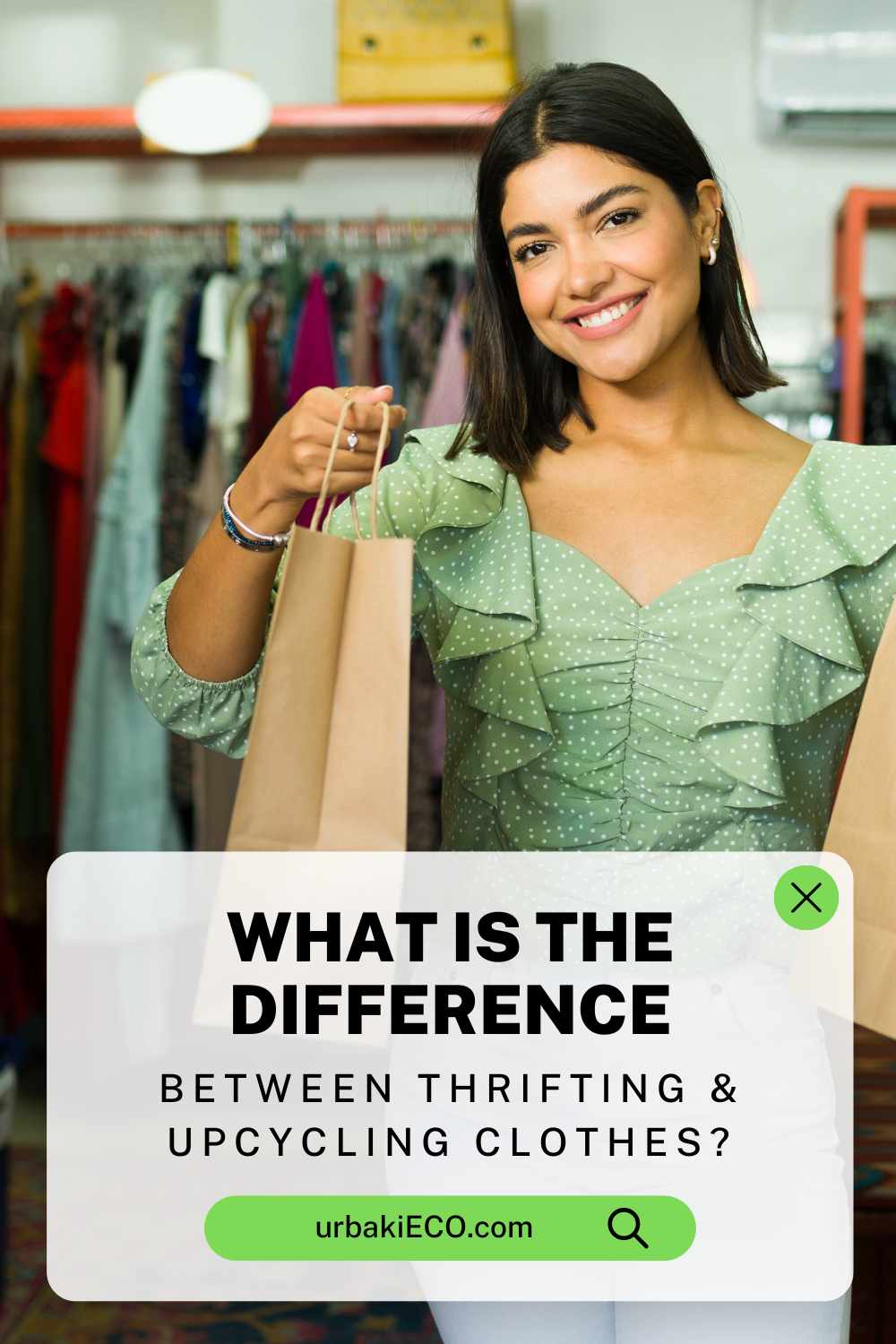What is The Difference Between Thrifting & Upcycling Clothes?

Sustainable fashion has grown in popularity, with practices like thrifting and upcycling becoming common solutions for reducing waste and making stylish, eco-friendly choices.
While these terms are often used interchangeably, they describe distinct approaches to extending the life of garments.
Knowing the difference helps you choose the best method for your needs and contribute meaningfully to a greener future.
What Is Thrifting?
Thrifting refers to buying second-hand clothing and accessories, typically from thrift stores, consignment shops, or online marketplaces.
The focus is on reusing items in their current form, often at a fraction of their original price. Thrifted clothing ranges from vintage treasures to contemporary brands, offering a mix of affordability and individuality.
For many, thrifting is an exciting hunt for hidden gems. The thrill lies in finding unique pieces that can’t be purchased in regular retail stores.
Additionally, it’s a great way to access high-quality garments that may otherwise be unaffordable. Thrifting supports a circular economy by giving pre-loved clothing a second life, reducing the demand for new production, and lowering the environmental footprint of fashion.
Related reading: Sustainable Fashion Made Easy: Upcycling Clothes from Thrift Stores
Sustainable Fashion Made Easy: Upcycling Clothes from Thrift Stores
What Is Upcycling?
Upcycling takes second-hand clothing to the next level by transforming old garments into something new and often more valuable. This creative process involves altering, embellishing, or completely redesigning an item to give it a fresh purpose.
For instance, a worn-out pair of jeans might become a trendy tote bag or a plain T-shirt could be revamped with embroidery or dyeing techniques.
Unlike thrifting, upcycling requires an investment of time and creativity. It’s about seeing the potential in materials and reimagining how they can be used. For many, upcycling is as much about the process as the result—it’s an opportunity to express personal style while practicing sustainability.
The Key Differences Between Thrifting and Upcycling
The main distinction lies in how the items are used. Thrifting focuses on extending the life of clothing without altering its form, while upcycling involves modifying garments to create something new.
Thrifting is typically a quicker and more convenient option, perfect for those looking to refresh their wardrobe without much effort. On the other hand, upcycling is ideal for individuals who enjoy crafting or want to add a personal touch to their fashion choices.
Thrifting relies on the existing inventory of second-hand stores, whereas upcycling can be done with clothing you already own or items sourced from thrift shops.
Related reading: What Methods Can Be Used to Create Recycled Fashion?
What Methods Can Be Used to Create Recycled Fashion?Both methods help reduce waste and minimize the environmental impact of fashion, but upcycling offers the added benefit of turning old items into custom, one-of-a-kind pieces.

Environmental Impact of Both Practices
Thrifting and upcycling both contribute to sustainability by addressing the waste associated with fast fashion. Thrifting extends the life cycle of garments, preventing them from ending up in landfills prematurely.
By purchasing second-hand, you also reduce the demand for new clothing production, which is resource-intensive and contributes to pollution.
Upcycling goes a step further by creatively repurposing items that might otherwise be discarded. This process reduces waste while promoting innovation and resourcefulness.
By upcycling, you can give clothing a new purpose and avoid the energy and materials required to manufacture new products.
Benefits of Thrifting
Thrifting offers several advantages beyond environmental benefits. It’s a budget-friendly way to shop, providing access to high-quality brands at lower prices.
Related reading: Budget-Friendly Recycled Fashion for Students
Budget-Friendly Recycled Fashion for StudentsFor those who value unique style, thrift stores are a treasure trove of vintage and rare finds that can’t be replicated by mass-produced fashion.
Additionally, thrifting supports local businesses and charities. Many thrift shops are run by non-profit organizations, meaning your purchases often contribute to community programs. It’s a win-win situation that combines eco-conscious shopping with social impact.

Advantages of Upcycling
Upcycling allows you to express your creativity and create pieces that reflect your style. It’s a highly customizable approach to fashion, letting you transform old or damaged items into something entirely new.
This makes upcycling a powerful tool for reducing textile waste while crafting unique, high-value items.
Upcycling also encourages skill development, from sewing and dyeing to designing and crafting. It’s a hands-on activity that promotes mindfulness and a deeper appreciation for the resources involved in fashion.
Plus, it fosters a stronger emotional connection to your clothing, making you more likely to cherish and care for your creations.
Related reading: Creative Ways to Repurpose Recycled Tin Cans
Creative Ways to Repurpose Recycled Tin CansHow to Combine Thrifting and Upcycling
Thrifting and upcycling don’t have to be separate practices—they complement each other beautifully. You can thrift items specifically for upcycling, turning second-hand garments into personalized creations.
For example, you might find a simple dress at a thrift shop and transform it into a unique piece by adding embellishments or altering the fit.
Combining these practices maximizes their benefits. Thrifting provides affordable materials, while upcycling adds value and creativity. Together, they create a sustainable, stylish, and fun approach to fashion.

Inspiring a Sustainable Fashion Culture
Both thrifting and upcycling play a role in shifting toward a more sustainable fashion industry. They challenge the throwaway culture of fast fashion by encouraging people to value and preserve their clothing.
By participating in these practices, you set an example for others and contribute to a broader movement that prioritizes sustainability over excess.
Choosing to thrift or upcycle helps redefine what fashion can be—creative, resourceful, and environmentally responsible. It’s a small change that, collectively, can make a big impact on the planet.
Related reading: How to Reduce Wasteful Spending & Save More Sustainably
How to Reduce Wasteful Spending & Save More SustainablyDid you find this post useful or inspiring? Save THIS PIN to your ECO Board on Pinterest! 😊



You may also like